Form HUD 96010 HUD 96010 FSS
"Logic Model" Grant Performance Report Standard
HUD 96010 FSS FY2014 Logic Model.xlsx
"Logic Model" Grant Performance Report Standard
OMB: 2535-0114
Document [xlsx]
Download: xlsx | pdf
Coversheet
Worksheet
Reporting
GoalsPriorities
Needs
Services
Outcomes
Tools
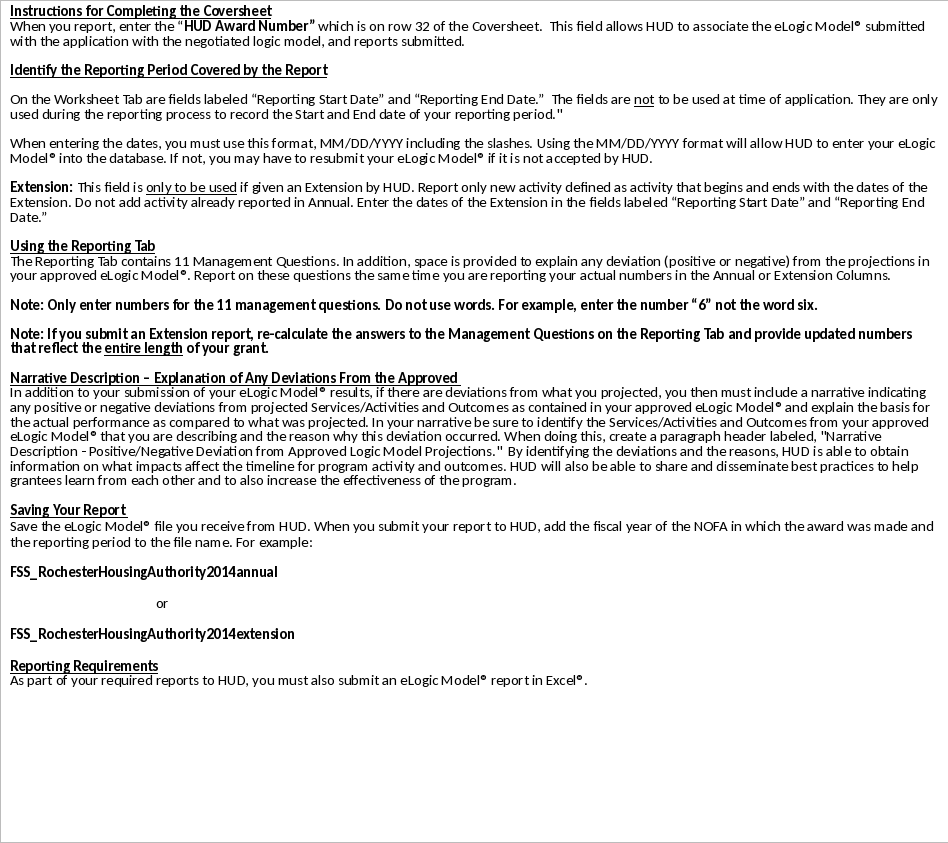


Overview
InstructionsCoversheet
Worksheet
Reporting
GoalsPriorities
Needs
Services
Outcomes
Tools
Sheet 1: Instructions

|
||||||||
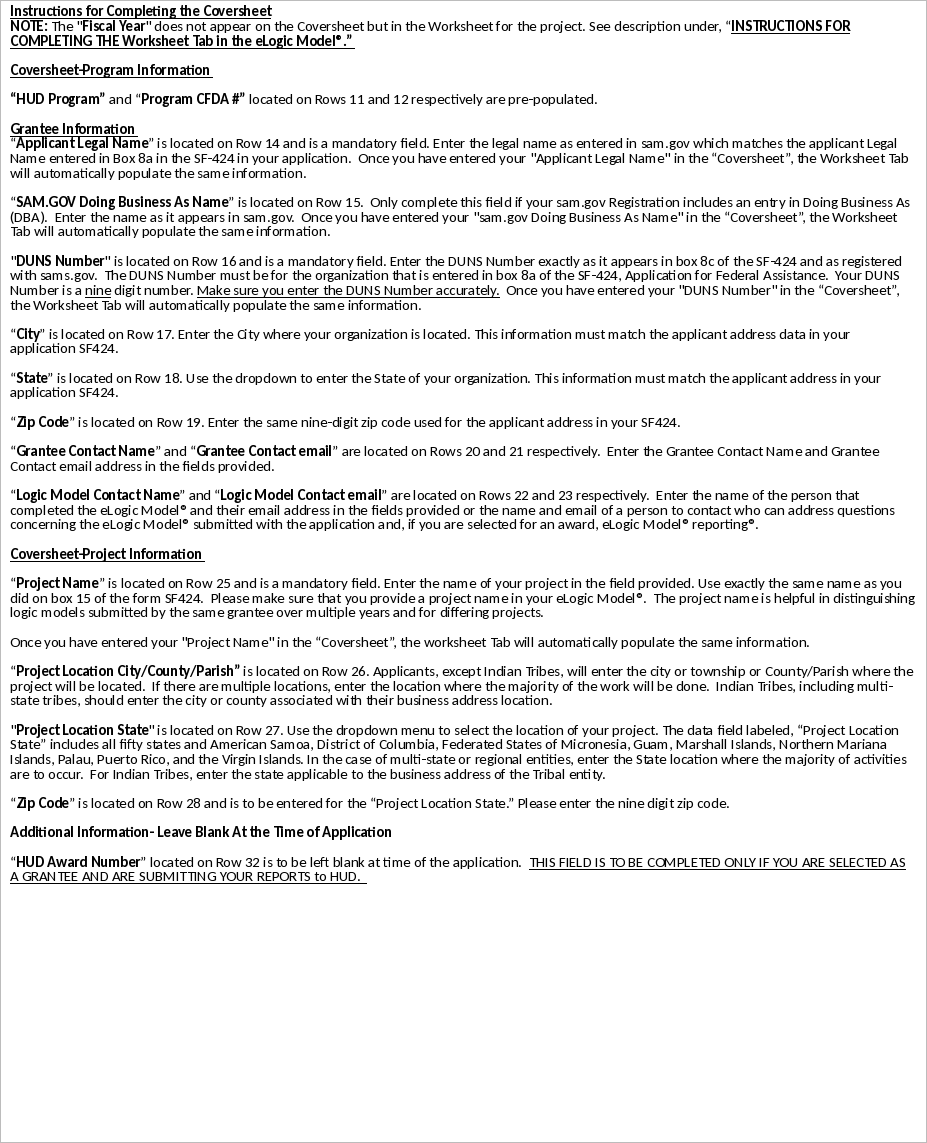
|
||||||||
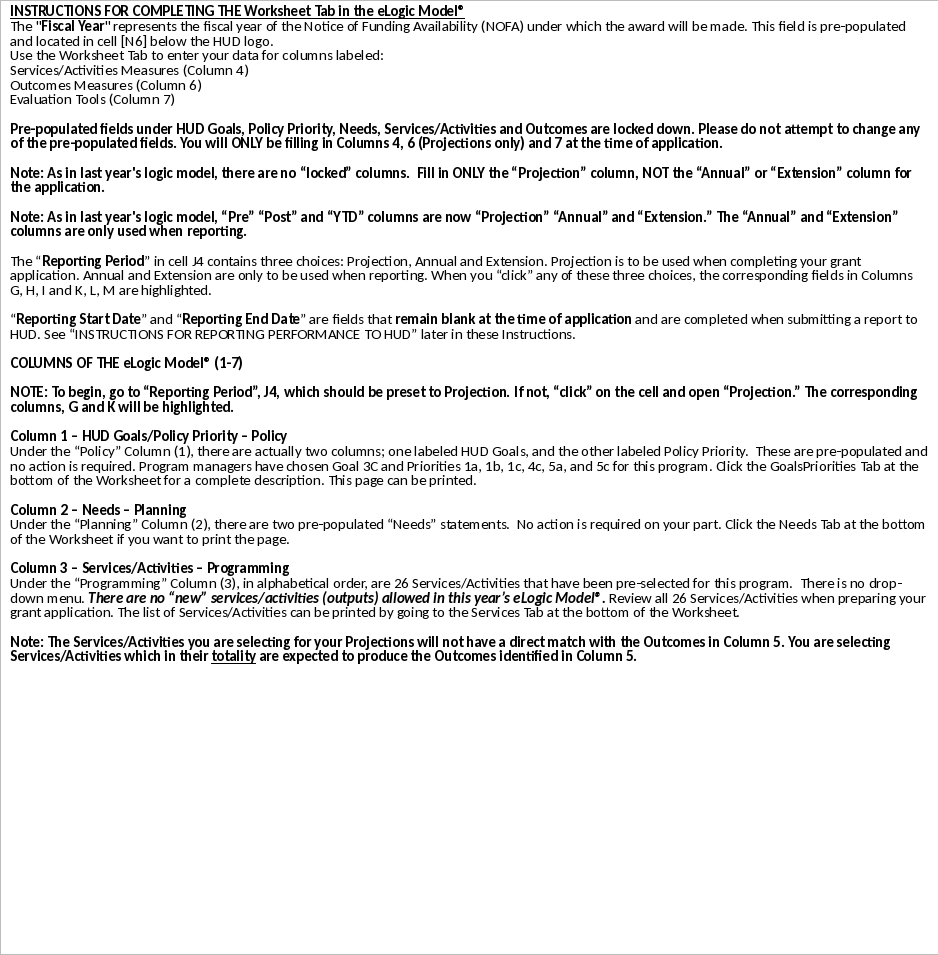
|
||||||||

|
||||||||
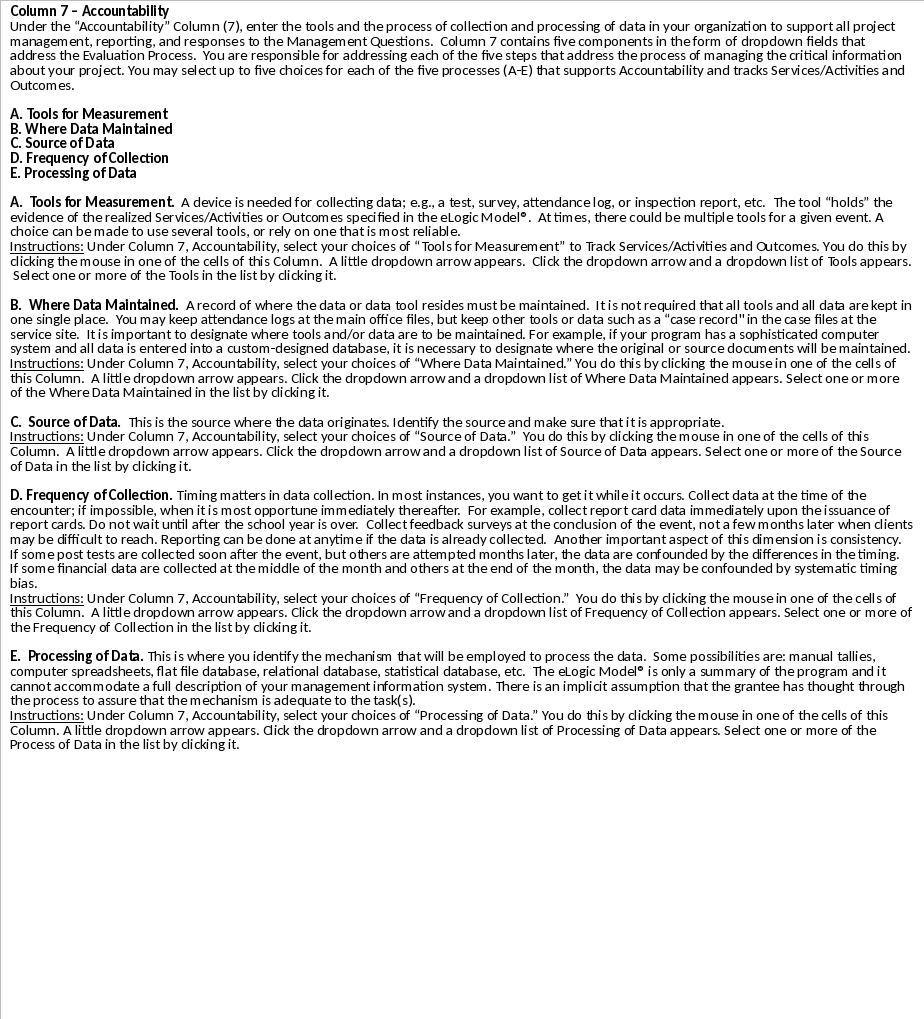
|
||||||||
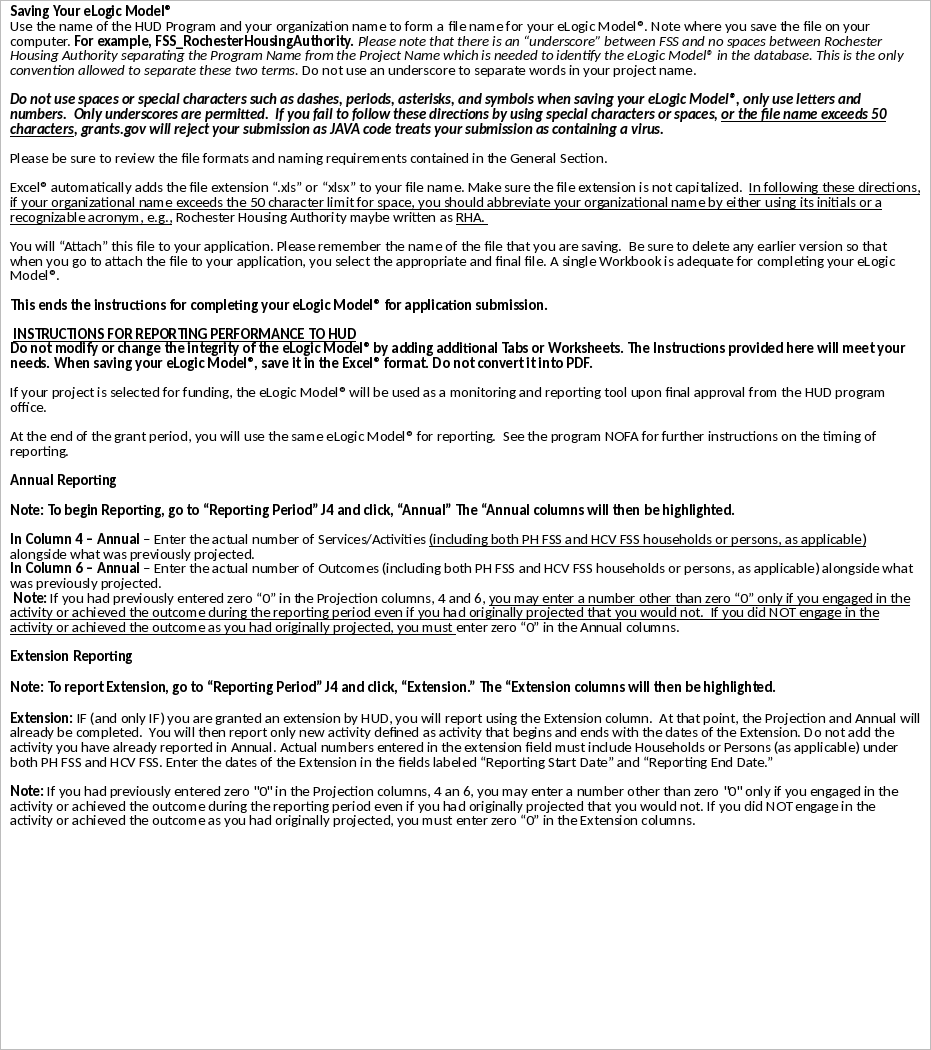
|
||||||||

Sheet 2: Coversheet

Sheet 3: Worksheet
| eLogic Model® | Worksheet | OMB Approval 2535-0114 exp. 08/31/2014 | |||||||||||
| Applicant Legal Name | 0 | ||||||||||||
| CCR Doing Business As Name | 0 | ||||||||||||
| HUD Program | FSS | Reporting Period | Projection | ||||||||||
| Reporting Start Date | DUNS No. | 0 | |||||||||||
| Project Name | 0 | Reporting End Date | FY 2014 | ||||||||||
| HUD Goals | Policy Priority | Needs | Services/Activities | Measures | Outcomes | Measures | Evaluation Tools | ||||||
| 1 | 2 | 3 | 4 | 5 | 6 | 7 | |||||||
| Policy | Planning | Programming | Projection | Annual | Extension | Impact | Projection | Annual | Extension | Accountability | |||
| 3c | 1a 1b 1c 4c 5a 5c |
There is a need to link new FSS program participants to services and economic opportunities that will lead to employment and economic self-sufficiency. There is a need to maintain on-going linkages to services and economic opportunities for existing FSS program participants in order to support their transition to employment and economic self-sufficiency. |
Child Care-Families linked to Child Care Services | Households | Persons | ||||||||
| Education-Associates degree obtained | A. Tools for Measurement | ||||||||||||
| Education-Participation in Adult Basic Education | Persons | Persons | |||||||||||
| Education-Bachelors degree obtained | |||||||||||||
| Education-Participation in ESL classes | Persons | Persons | |||||||||||
| Education-Adult Basic Education-Completed | |||||||||||||
| Education-Participation in High School/GED program | Persons | Persons | |||||||||||
| The Extension field is only to be used if given an extension from HUD. Report only new activity defined as activity that begins and ends with the dates of the extension. Do not add activity reported in Annual. |
Education-Certification from technical school | B. Where Data Maintained | |||||||||||
| Education-Participation in Post secondary classes | Persons | Persons | |||||||||||
| Education-ESL-Completed | |||||||||||||
| Employment-Job retention activities | Persons | Persons | |||||||||||
| Education-GED/High School diploma obtained | |||||||||||||
| Financial Literacy-Escrow accounts established | Persons | Persons | |||||||||||
| Employment-Employment obtained (including apprenticeship) | C. Source of Data | ||||||||||||
| Financial Literacy-Tax Preparation assistance provided | Persons | Persons | |||||||||||
| Employment-Employment increased from part-time to full-time (32+ hours) | |||||||||||||
| Financial Literacy-IDA accounts (not escrow) established | Persons | Persons | |||||||||||
| Employment-Promotion/new job resulting in increased hourly wage | |||||||||||||
| Financial Literacy-Individualized Counseling | Persons | Persons | |||||||||||
| Employment-Maintain employment greater than one year | D. Frequency of Collection | ||||||||||||
| Financial Literacy-Classroom Setting Financial Education (participation) | Persons | Persons | |||||||||||
| Employment-Employer-Provided health benefits obtained | |||||||||||||
| Health-Referral for health care services (physical/dental) | Persons | Households | |||||||||||
| Financial Literacy-EITC received | |||||||||||||
| Health-Referral for mental health services | Persons | Households | |||||||||||
| Housing-Increased earned income results in no longer needing rental assistance | E. Processing of Data | ||||||||||||
| Health-Referral for substance abuse services | Persons | Households | |||||||||||
| Housing-Purchased home with HCV Homeownership Assistance | |||||||||||||
| Housing-Homeownership counseling | Persons | Households | |||||||||||
| Housing-Purchased home without HCV Homeownership Assistance | |||||||||||||
| Service Coordination-New families enrolled (new CoPs) | Households | ||||||||||||
| Service Coordination-Families continuing to receive service coordination | Households | ||||||||||||
| Service Coordination-Families graduated | Households | ||||||||||||
| Service Coordination-Individuals served (unduplicated count) | Persons | ||||||||||||
| Training-Job Preparation/Counseling (soft skills)-Enrolled | Persons | ||||||||||||
| Training-Job Preparation/Counseling (soft skills)-Completed | Persons | ||||||||||||
| Training-Job Training (for specific job/type of job)-Enrolled | Persons | ||||||||||||
| Training-Job Training (for specific job/type of job)-Completed | Persons | ||||||||||||
| Training-Parenting/Household Skills/Life Skills (non-job training)-Enrolled | Persons | ||||||||||||
| Training-Parenting/Household Skills/Life Skills (non-job training)-Completed | Persons | ||||||||||||
| Transportation-Transportation services to enable service provision/employment | Persons | ||||||||||||
Sheet 4: Reporting
| Carter-Richmond Methodology | |||||||
| The Management Questions developed for your program are based on the Carter-Richmond Methodology.* A description of the Carter-Richmond Methodology appears in the General Section of the NOFA. | |||||||
| * © The Accountable Agency – How to Evaluate the Effectiveness of Public and Private Programs,” Reginald Carter, ISBN Number 9780978724924 | |||||||
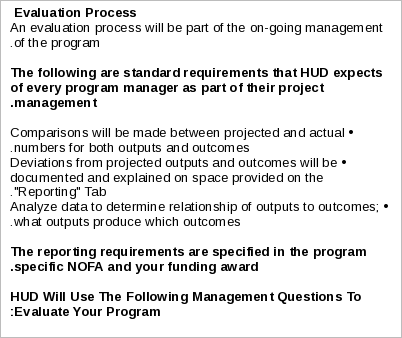
|
|||||||
| Response to Management Questions | Measure | Answer | |||||
| 1 | How many households were under Contracts of Participation (unduplicated count)? | Households | |||||
| 2 | How many persons received services (unduplicated count)? | Persons | |||||
| 3 | How many partners are providing services (unduplicated count)? | Partners | |||||
| 4 | How many households successfully completed their Contract of Participation/Graduated? | Households | |||||
| 5 | What is the value of the dollars and services leveraged by this grant? | Dollars | $0.00 | ||||
| Please work with your service partners to determine a dollar value for each service provided. For example, if the cost of a GED class is $300 and three FSS participants attend, the reported value would be $900. Repeat this for any services provided by your partners and add the total. If the grant was also used to leverage cash, please add this to the total. If you would like to provide any additional details on the value of leveraged services and funds, please use the blank text box below the field labeled, Explanation of Any Deviations from the Approved eLogic Model® | |||||||
| 6 | How many persons receiving services are under the age of 6? | Persons | |||||
| 7 | How many persons receiving services are ages 6-17? | Persons | |||||
| 8 | How many persons receiving services are ages 18-30? | Persons | |||||
| 9 | How many persons receiving services are ages 31-50? | Persons | |||||
| 10 | How many persons receiving services are ages 51-61? | Persons | |||||
| 11 | How many persons receiving services are over 62 years of age? | Persons | |||||
| (The total number of persons reported in questions 6-11 should equal the total number of unduplicated individuals reported in question 2 above). | |||||||

|
|||||||

|
|||||||
| ALABAMA | |||||||
| ALASKA | |||||||
| AMERICAN SAMOA | |||||||
| ARIZONA | |||||||
| ARKANSAS | |||||||
| CALIFORNIA | |||||||
| COLORADO | |||||||
| CONNECTICUT | |||||||
| DELAWARE | |||||||
| DISTRICT OF COLUMBIA | |||||||
| FEDERATED STATES OF MICRONESIA | |||||||
| FLORIDA | |||||||
| GEORGIA | |||||||
| GUAM | |||||||
| HAWAII | |||||||
| IDAHO | |||||||
| ILLINOIS | |||||||
| INDIANA | |||||||
| IOWA | |||||||
| KANSAS | |||||||
| KENTUCKY | |||||||
| LOUISIANA | |||||||
| MAINE | |||||||
| MARSHALL ISLANDS | |||||||
| MARYLAND | |||||||
| MASSACHUSETTS | |||||||
| MICHIGAN | |||||||
| MINNESOTA | |||||||
| MISSISSIPPI | |||||||
| MISSOURI | |||||||
| MONTANA | |||||||
| NEBRASKA | |||||||
| NEVADA | |||||||
| NEW HAMPSHIRE | |||||||
| NEW JERSEY | |||||||
| NEW MEXICO | |||||||
| NEW YORK | |||||||
| NORTH CAROLINA | |||||||
| NORTH DAKOTA | |||||||
| NORTHERN MARIANA ISLANDS | |||||||
| OHIO | |||||||
| OKLAHOMA | |||||||
| OREGON | |||||||
| PALAU | |||||||
| PENNSYLVANIA | |||||||
| PUERTO RICO | |||||||
| RHODE ISLAND | |||||||
| SOUTH CAROLINA | |||||||
| SOUTH DAKOTA | |||||||
| TENNESSEE | |||||||
| TEXAS | |||||||
| UTAH | |||||||
| VERMONT | |||||||
| VIRGIN ISLANDS | |||||||
| VIRGINIA | |||||||
| WASHINGTON | |||||||
| WEST VIRGINIA | |||||||
| WISCONSIN | |||||||
| WYOMING | |||||||

Sheet 5: GoalsPriorities
| HUD Goals | HUD Priorities | |||
| 1A | Strengthen the Nation’s Housing Market to Bolster the Economy and Protect Consumers (1A) Stem the foreclosure crisis. | 1a | Job Creation/Employment (1a) Improving access to job opportunities through information sharing, coordination with federal, state, and local entities, and other means. | |
| 1B | Strengthen the Nation’s Housing Market to Bolster the Economy and Protect Consumer (1B) Protect and educate consumers when they buy, refinance or rent a home. | 1b | Job Creation/Employment (1b) Increasing access to job training, career services, and work, supports through coordination with federal, state, and local entities. | |
| 1C | Strengthen the Nation’s Housing Market to Bolster the Economy and Protect Consumers (1C) Create financially sustainable homeownership opportunities. | 1c | Job Creation/Employment (1c) Expanding economic and job creation opportunities for low-income residents and creating better transportation access to those jobs and other economic opportunities by partnering with federal and nonprofit agencies, private industry, and planning and economic development organizations and by leveraging federal and private resources. | |
| 1D | Strengthen the Nation’s Housing Market to Bolster the Economy and Protect Consumers (1D) Establish an accountable and sustainable housing finance system. | 2a | Sustainability (2a) Promote and preserve community assets including small businesses, fresh food markets, parks, hospitals, and quality schools by incentivizing comprehensive and inclusive local economic development planning. | |
| 2A | Meet the Need for Quality Affordable Rental Homes (2A) End homelessness and substantially reduce the number of families and individuals with severe housing needs. | 2b | Sustainability (2b) Give consumers more information about the true cost of living by incorporating both housing and transportation costs into measures of affordability. | |
| 2B | Meet the Need for Quality Affordable Rental Homes (2B) Expand the supply of affordable rental homes where most needed. | 2c | Sustainability (2c) Improve residents’ health and safety, particularly that of children and other vulnerable populations, by promoting green and healthy design, construction, rehabilitation, and maintenance of housing and communities. | |
| 2C | Meet the Need for Quality Affordable Rental Homes (2C) Preserve the affordability and improve the quality of federally assisted and private unassisted affordable rental homes. | 2d | Sustainability (2d) Support and promote an energy-efficient, green, and healthy housing market by retrofitting existing housing, supporting energy-efficient new construction, improving home energy labeling, and promoting financing products that reduce the carbon footprint of non-HUD-supported residential buildings. | |
| 2D | Meet the Need for Quality Affordable Rental Homes (2D) Expand families' choices of affordable rental homes located in a broad range of communities. | 2e | Sustainability (2e) Reduce energy consumption and incorporate green building practices in the design and operation of HUD-supported affordable housing. | |
| 3A | Utilize Housing as a Platform for Improving Quality of Life (3A) Utilize HUD assistance to improve educational outcomes and early learning and development. | 2f | Sustainability (2f) Promote coordinated planning, integrating federal resources, and targeting technical assistance at the local, state, and regional levels for sustainable housing and communities. | |
| 3B | Utilize Housing as a Platform for Improving Quality of Life (3B) Utilize HUD assistance to improve health outcomes. | 2g | Sustainability (2g) Promote the design and construction of buildings and communities that are accessible and visitable by people with disabilities. | |
| 3C | Utilize Housing as a Platform for Improving Quality of Life (3C) Utilize HUD assistance to increase economic security and self-sufficiency. | 2h | Sustainability (2h) Promote the use of climate-resilient and disaster-resistant building design, construction and siting. | |
| 3D | Utilize Housing as a Platform for Improving Quality of Life (3D) Utilize HUD assistance to improve housing stability through supportive services for vulnerable populations including the elderly, people with disabilities, homeless people, and those individuals and families at risk of becoming homeless. | 2i | Sustainability (2i) Encourage metropolitan and regional focus in planning and community development. | |
| 3E | Utilize Housing as a Platform for Improving Quality of Life (3E) Utilize HUD assistance to improve public safety. | 3a | Affirmatively Furthering Fair Housing (3a) Regional coordination of affirmatively furthering fair housing plans, including such activities as developing regional analyses of impediments. | |
| 4A | Build Inclusive and Sustainable Communities Free from Discrimination (4A) Catalyze economic development and job creation, while enhancing and preserving community assets. | 3b | Affirmatively Furthering Fair Housing (3b) Regional strategies to reduce racially segregated living patterns and other effects of formely de jure segregated public or assisted housing in metropolitan areas with a year 2000 dissimilarity index of 70 or higher and where the minority population is at least 20,000 or 3 percent of the total population in the Core Based Statistical Area (CBSA), whichever is greater. | |
| 4B | Build Inclusive and Sustainable Communities Free from Discrimination (4B) Promote energy efficient buildings and location efficient communities that are healthy, affordable and diverse. | 3c | Affirmatively Furthering Fair Housing (3c) Decreasing the concentration of poverty and racial segregation in neighborhoods and communities through strategic targeting of resources. | |
| 4C | Build Inclusive and Sustainable Communities Free from Discrimination (4C) Ensure open, diverse, and equitable communities. | 3d | Affirmatively Furthering Fair Housing (3d) Promoting visitability for persons with disabilities in single-family housing. | |
| 4D | Build Inclusive and Sustainable Communities Free from Discrimination (4D) Facilitate disaster preparedness, recovery and resiliency. | 4a | Capacity Building and Knowledge Sharing (4a) Develop, target and deliver technical assistance for increasing affordability in areas experiencing increased rental costs due to development. | |
| 4E | Build Inclusive and Sustainable Communities Free from Discrimination (4E) Build the capacity of local, state and regional public and private organizations. | 4b | Capacity Building and Knowledge Sharing (4b) Strengthen the capacity of state and local partners, including governments and nonprofit organizations, to implement HUD programs, participate in decision making and planning processes, and coordinate on cross-programmatic, place-based approaches through grantmaking and technical assistance. | |
| 5A | Transform the Way HUD Does Business (5A) Build Capacity: Create a flexible and high performing learning organization with a motivated, skilled workforce. | 4c | Capacity Building and Knowledge Sharing (4c) Support knowledge sharing and innovation by disseminating best practices, encouraging peer learning, publishing data analysis and research, and helping to incubate and test new ideas. | |
| 5B | Transform the Way HUD Does Business (5B) Focus on Results: Create an empowered organization that is customer-centered, place based, collaborative, and responsive to employee feedback and focused on results. | 5a | Using Housing as a Platform for Improving Other Outcomes (5a) Increasing access to high quality early learning programs and services through coordination with local programs. | |
| 5C | Transform the Way HUD Does Business (5C) Bureaucracy Busting: Create flexible, modern rules and systems that promote responsiveness, openness and transparency. | 5b | Using Housing as a Platform for Improving Other Outcomes (5b) Providing physical space to co-locate healthcare and wellness services with housing (e.g., on-site health clinics). | |
| 5D | Transform the Way HUD Does Business (5D) Culture Change: Create a healthy, open, flexible work environment that reflects the values of HUD’s mission. | 5c | Using Housing as a Platform for Improving Other Outcomes (5c) Increasing access to public benefits (such as Temporary Assistance to Needy Families and Supplemental Security Income) through outreach and other means. | |
| 5d | Using Housing as a Platform for Improving Other Outcomes (5d) Maintaining or improving the physical environment and design of HUD-assisted residences, giving attention to physical safety and crime prevention. | |||
| 5e | Using Housing as a Platform for Improving Other Outcomes (5e) Providing mobility counseling to increase access to neighborhoods of opportunity. | |||
| 6a | Expand Cross-Cutting Policy Knowledge (6a) Support knowledge sharing and innovation by disseminating best practices, encouraging peer learning, publishing data analysis and research, and helping to incubate and test new ideas. |
Sheet 6: Needs
| CAMP eLogic Model® |
| Column 2 |
| NEEDS |
| There is a need to link new FSS program participants to services and economic opportunities that will lead to employment and economic self-sufficiency. |
| There is a need to maintain on-going linkages to services and economic opportunities for existing FSS program participants in order to support their transition to employment and economic self-sufficiency. |
Sheet 7: Services
| CAMP eLogic Model® |
|
| Column 3 | |
| SERVICES/ACTIVITIES | UNITS |
| Child Care-Families linked to Child Care Services | Households |
| Education-Participation in Adult Basic Education | Persons |
| Education-Participation in ESL classes | Persons |
| Education-Participation in High School/GED program | Persons |
| Education-Participation in Post secondary classes | Persons |
| Employment-Job retention activities | Persons |
| Financial Literacy-Escrow accounts established | Persons |
| Financial Literacy-Tax Preparation assistance provided | Persons |
| Financial Literacy-IDA accounts (not escrow) established | Persons |
| Financial Literacy-Individualized Counseling | Persons |
| Financial Literacy-Classroom Setting Financial Education (participation) | Persons |
| Health-Referral for health care services (physical/dental) | Persons |
| Health-Referral for mental health services | Persons |
| Health-Referral for substance abuse services | Persons |
| Housing-Homeownership counseling | Persons |
| Service Coordination-New families enrolled (new CoPs) | Households |
| Service Coordination-Families continuing to receive service coordination | Households |
| Service Coordination-Families graduated | Households |
| Service Coordination-Individuals served (unduplicated count) | Persons |
| Training-Job Preparation/Counseling (soft skills)-Enrolled | Persons |
| Training-Job Preparation/Counseling (soft skills)-Completed | Persons |
| Training-Job Training (for specific job/type of job)-Enrolled | Persons |
| Training-Job Training (for specific job/type of job)-Completed | Persons |
| Training-Parenting/Household Skills/Life Skills (non-job training)-Enrolled | Persons |
| Training-Parenting/Household Skills/Life Skills (non-job training)-Completed | Persons |
| Transportation-Transportation services to enable service provision/employment | Persons |
Sheet 8: Outcomes
| CAMP eLogic Model® |
|
| Column 5 | |
| OUTCOMES | UNITS |
| Education-Associates degree obtained | Persons |
| Education-Bachelors degree obtained | Persons |
| Education-Adult Basic Education-Completed | Persons |
| Education-Certification from technical school | Persons |
| Education-ESL-Completed | Persons |
| Education-GED/High School diploma obtained | Persons |
| Employment-Employment obtained (including apprenticeship) | Persons |
| Employment-Employment increased from part-time to full-time (32+ hours) | Persons |
| Employment-Promotion/new job resulting in increased hourly wage | Persons |
| Employment-Maintain employment greater than one year | Persons |
| Employment-Employer-Provided health benefits obtained | Persons |
| Financial Literacy-EITC received | Persons |
| Housing-Increased earned income results in no longer needing rental assistance | Households |
| Housing-Purchased home with HCV Homeownership Assistance | Households |
| Housing-Purchased home without HCV Homeownership Assistance | Households |
Sheet 9: Tools
| CAMP eLogic Model® |
| A. Tools For Measurement |
| Bank accounts |
| Construction log |
| Database |
| Enforcement log |
| Financial aid log |
| Intake log |
| Interviews |
| Mgt. Info. System-automated |
| Mgt. Info. System-manual |
| Outcome scale(s) |
| Phone log |
| Plans |
| Pre-post tests |
| Post tests |
| Program specific form(s) |
| Questionnaire |
| Recruitment log |
| Survey |
| Technical assistance log |
| Time sheets |
| B. Where Data Maintained |
| Agency database |
| Centralized database |
| Individual case records |
| Local precinct |
| Public database |
| School |
| Specialized database |
| Tax Assessor database |
| Training center |
| C. Source of Data |
| Audit report |
| Business licenses |
| Certificate of Occupancy |
| Code violation reports |
| Counseling reports |
| Employment records |
| Engineering reports |
| Environmental reports |
| Escrow accounts |
| Financial reports |
| GED certification/diploma |
| Health records |
| HMIS |
| Inspection results |
| Lease agreements |
| Legal documents |
| Loan monitoring reports |
| Mortgage documents |
| Payment vouchers |
| Permits issued |
| Placements |
| Progress reports |
| Referrals |
| Sale documents |
| Site reports |
| Statistics |
| Tax assessments |
| Testing results |
| Waiting lists |
| Work plan reports |
| D. Frequency of Collection |
| Daily |
| Weekly |
| Monthly |
| Quarterly |
| Biannually |
| Annually |
| Upon incident |
| E. Processing of Data |
| Computer spreadsheets |
| Flat file database |
| Manual tallies |
| Relational database |
| Statistical database |
| File Type | application/vnd.openxmlformats-officedocument.spreadsheetml.sheet |
| File Modified | 0000-00-00 |
| File Created | 0000-00-00 |
© 2026 OMB.report | Privacy Policy